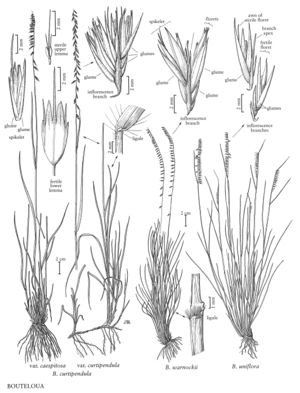Difference between revisions of "Bouteloua uniflora"
FNA>Volume Importer |
imported>Volume Importer |
||
| (5 intermediate revisions by 2 users not shown) | |||
| Line 17: | Line 17: | ||
-->{{Treatment/Body | -->{{Treatment/Body | ||
|distribution=Tex. | |distribution=Tex. | ||
| − | |discussion=<p><i>Bouteloua uniflora</i> grows primarily in fertile, rocky, limestone soils of Texas and adjacent Coahuila, Mexico at 300-1000 m. A disjunct collection has been reported from Zion National Park, Utah. Plants in the Flora region belong to <i>Bouteloua uniflora</i> Vasey < | + | |discussion=<p><i>Bouteloua uniflora</i> grows primarily in fertile, rocky, limestone soils of Texas and adjacent Coahuila, Mexico at 300-1000 m. A disjunct collection has been reported from Zion National Park, Utah. Plants in the Flora region belong to <i>Bouteloua uniflora</i> Vasey <i></i>var.<i> uniflora</i>, which differs from <i>B. uniflora</i> <i></i>var.<i> coahuilensis</i> Gould & Kapadia in having taller (40-60 cm, not 20-40 cm) leafy, rather than scapose, culms, longer leaf blades (12-16 cm versus 6-12 cm), and 50-70, rather than 15-40, panicle branches.</p> |
|tables= | |tables= | ||
|references= | |references= | ||
| Line 26: | Line 26: | ||
-->{{#Taxon: | -->{{#Taxon: | ||
name=Bouteloua uniflora | name=Bouteloua uniflora | ||
| − | |||
|authority=Vasey | |authority=Vasey | ||
|rank=species | |rank=species | ||
| Line 33: | Line 32: | ||
|basionyms= | |basionyms= | ||
|family=Poaceae | |family=Poaceae | ||
| + | |illustrator=Linda A. Vorobik;Cindy Roché | ||
| + | |illustration copyright=Utah State University | ||
|distribution=Tex. | |distribution=Tex. | ||
|reference=None | |reference=None | ||
| Line 38: | Line 39: | ||
|publication year= | |publication year= | ||
|special status= | |special status= | ||
| − | |source xml=https:// | + | |source xml=https://bitbucket.org/aafc-mbb/fna-data-curation/src/200273ad09963decb8fc72550212de541d86569d/coarse_grained_fna_xml/V25/V25_872.xml |
|subfamily=Poaceae subfam. Chloridoideae | |subfamily=Poaceae subfam. Chloridoideae | ||
|tribe=Poaceae tribe Cynodonteae | |tribe=Poaceae tribe Cynodonteae | ||
Latest revision as of 17:59, 11 May 2021
Plants perennial; cespitose, without rhizomes or stolons. Culms 20-60 cm, stiffly erect, glabrous. Sheaths mostly glabrous, a few long hairs present near the ligules; ligules 0.2-0.5 mm, of hairs; blades 6-16 cm long, 1-2 mm wide, involute when dry, glabrous, bases usually with papillose-based hairs on the margins. Panicles 5-10(14) cm, with 15-70 branches; branches 5-9 mm, deciduous, scabrous, with 1 spikelet (lower branches occasionally with 2 spikelets), axes extending 3-4 mm beyond the terminal spikelets, apices entire; disarticulation at the base of the branches. Spikelets appressed, with 1 bisexual and 0-1 rudimentary florets. Glumes acute to slightly cleft and minutely apiculate, midveins usually scabrous; lower glumes 2.5-4 mm; upper glumes 6.2-8 mm, mostly smooth, midveins usually scabrous; lowest lemmas 6-7.5 mm, acute or minutely cleft, glabrous, unawned, sometimes mucronate; lowest paleas unawned, glabrous; anthers 2.5-3 mm, bright yellow; second florets absent or reduced to 1 or 3 short awns, glabrous. Caryopses about 3 mm. 2n = 20.
Discussion
Bouteloua uniflora grows primarily in fertile, rocky, limestone soils of Texas and adjacent Coahuila, Mexico at 300-1000 m. A disjunct collection has been reported from Zion National Park, Utah. Plants in the Flora region belong to Bouteloua uniflora Vasey var. uniflora, which differs from B. uniflora var. coahuilensis Gould & Kapadia in having taller (40-60 cm, not 20-40 cm) leafy, rather than scapose, culms, longer leaf blades (12-16 cm versus 6-12 cm), and 50-70, rather than 15-40, panicle branches.
Selected References
None.
